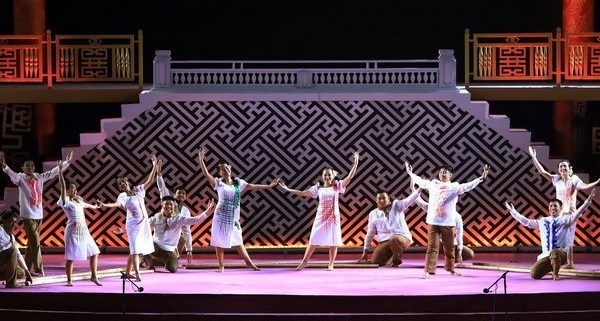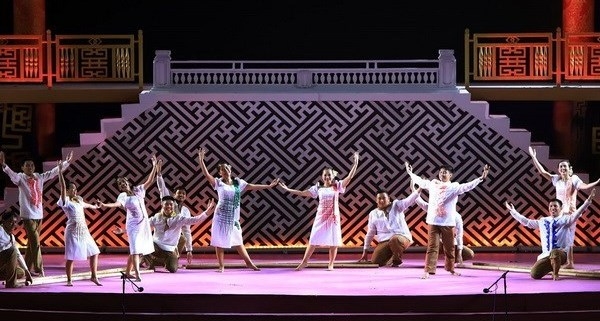
Foreign artists devoted their unique performances to entertain audiences at An Dinh Palace on April 30 as part of the ongoing Hue Festival 2018 in the central province of Thua Thien-Hue.

An art performance
at Hue Festival
(Photo: VNA)
Thousands of rock fans had a frenetic night with songs in the
debut album of France’s
rock band Lysistrata.
Meanwhile, Mongolian artists brought
their epics (Mongolian tuuli) – UNESCO-regconised Intangible Cultural Heritage
- traditional dances and music to the festival.
The Moroccan music troupe Majid Bekkas
entertained the audiences with its impressive performances which show a new
form of musical expression taking root from the spiritual music of Gnawa
trance, mixed with African jazz and blues.
Themed "Cultural Heritage with
Integration and Development: Hue
- One Destination, Five World Heritage”, the Hue Festival 2018, the 10th of its
kind, are taking place from April 27 to May 2.
According to the organising board,
during the first part of the festival from April 27-29, nearly 30 art
performance programmes and festivals were organised, attracting nearly 50,000
visitors to Thua Thien-Hue province per day.
Not only in Hue city, this year’s festival is also being
held in villages. Visitors are offered a chance to participate in a festival in
Phuoc Tich ancient village in Phong Dien district or join a market day in Thuy
Thanh commune, Huong Thuy town where they can enjoy the locality’s specialties.
Source: NDO
Hoa Binh province has carried out multiple programmes and initiatives to revive its cultural heritage which has gradually fallen into oblivion through the ebbs and flows of history.
The most prominent and defining feature in the prehistoric era of Hoa Binh is the Hoa Binh Culture. The Culture was first discovered in Hoa Binh. The significant prehistoric culture represents not only Vietnam but also Southeast Asia and southern China. Through excavations of cave sites in the limestone regions of Hoa Binh, French archaeologist M. Colani introduced the world to a "Stone Age in Hoa Binh province – Northern Vietnam" in 1927. On January 30, 1932, the First Congress of Far Eastern Prehistorians, held in Hanoi, officially recognised the Hoa Binh Culture.
Known as the "Land of Epic History”, Hoa Binh province, the gateway to Vietnam’s northwest, boasts a strategic location and a unique cultural tapestry woven by its ethnic minority communities.
The People's Committee of Luong Son District recently held a ceremony to receive the certificate recognizing Sau Communal House in Thanh Cao Commune as a provincial-level historical and cultural site.
Recognising the importance of cultural heritage preservation in protecting and promoting the value system of Vietnamese culture, and serving socio-economic development in the new period, Party committees and local administrations in Hoa Binh province have identified it as a key task in the cultural development strategy. The province has been making efforts in mobilising resources, creating consensus among people and engaging ethnic communities in preserving and promoting cultural identity.
Hoa Binh province has captured growing attention both domestically and internationally for its distinctive cultural heritage and rich history. Most notably, it has been renowned for its famous Hoa Binh culture, considered the cradle of ancient Vietnamese civilisation. Looking ahead to significant milestones in 2025 and the 140th anniversary of province establishment in 2026, Hoa Binh Newspaper presents a comprehensive overview of the province's development across economic, social, cultural, tourism, and security domains.



